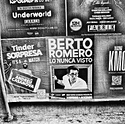rogueish said:
I've never heard of a bloting "cloth" but I do have
a blotting "paper" book. It worked fine the first time I used each page,
but the print emulsion started to stick to the page after that.
Turned out to be more of a pain in the a** than helpful.
Blotter books are worthless though blotter stacks are a boon if
you're not in a hurry. Stacks use very little space, no power,
and they are easily out of the way when not being used.
I've a stack built up from A flute ventilation corrugated board and
hydrophobic separator sheets. That last, an innovation on my part.
Quite a few layers may make-up a stack; lots of prints. I suggest
a separator sheet front and back; that is two sheets each layer.
I save up prints needing a flat dry. They are rewetted, sponge
dried, then given a few minutes of screen drying prior to placing in
the stack. After loading the stack is weighted. Two to four days
drying will be needed depending on humidity and air circulation.
www.forestry-suppliers.com has the A flute ventilators. Search
there for, A flute . 12 sheets, 12x18, $6.85 plus S&H. Dan










 this method works great with regular paper and single wieght paper too. i also have a bookbinders press, but don't use it as much as just "something heavy" ...
this method works great with regular paper and single wieght paper too. i also have a bookbinders press, but don't use it as much as just "something heavy" ...